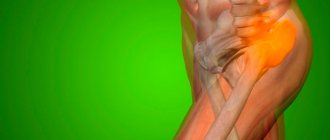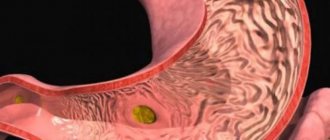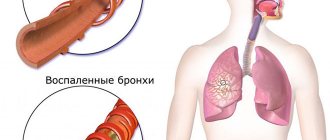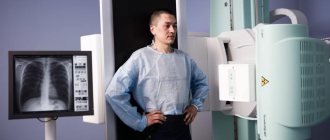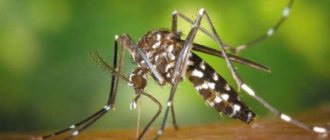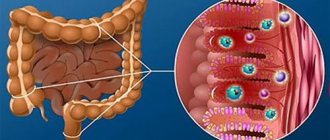Symptoms of esophageal candidiasis
The danger of infection lies in the fact that in some cases the symptoms are not clearly expressed - the patient may simply not attach any significance to them or confuse them with the manifestation of an existing chronic disease (for example, with gastritis, heartburn is a common occurrence).
Signs of esophageal candidiasis often resemble the picture with damage to the gastrointestinal tract:
- decreased appetite;
- weight loss;
- nausea (less often vomiting);
- heartburn;
- pain in the upper abdomen and behind the sternum;
- loose stool.
Esophageal candidiasis is also expressed by odynophagia (painful swallowing) and dysphagia (impaired process or inability to swallow food). With such disorders, food or liquid may enter the trachea, nose, or larynx. There may be white films in the vomit, and mucus and bloody discharge in the stool.
Damage to the esophageal mucosa initially appears as separate white areas. They then expand, forming a dense plaque. Underneath, the fungi spread deeper and deeper, reaching blood vessels and muscles.
Esophageal candidiasis occurs for various reasons:
- intestinal candidiasis (high probability);
- contact with an infected person or carrier;
- infected product;
- infection through household items or hygiene products;
- oral candidiasis.
The causes of esophageal candidiasis may be hidden in an imbalance of calcium-phosphorus metabolism. This happens when the functionality of the adrenal glands and thyroid gland is impaired.
There are certain risk factors for the development of esophageal candidiasis:
- reduced immunity;
- narrowed lumen of the esophagus (due to tumor, injury);
- diabetes;
- pathology of the digestive organs;
- intravenous (parenteral) nutrition (the gastrointestinal tract is not involved);
- allergy;
- chronic infections (often HIV, tuberculosis);
- smoking;
- alcoholism;
- long-term use of antibiotics or hormonal drugs;
- malnutrition;
- low acidity;
- taking corticosteroids;
- intoxication;
- taking antacids;
- organ transplantation.
This is not a complete list of factors influencing the development of fungal infection. The significance of each is determined by the state of the human immune system.
The disease is difficult to diagnose, since about a third of patients do not notice any changes and are not aware of the existence of a gastroenterological problem. However, some signs may indicate the development of pathology:
- pain in the upper abdomen and discomfort behind the sternum;
- pain and difficulty swallowing. The pain can range from barely noticeable to excruciating;
- decreased appetite, resulting in weight loss;
- heartburn, possible belching with a sour taste;
- inflammation in the oral cavity;
- nausea and vomiting with whitish patches;
- elevated temperature;
- diarrhea with mucus and cheesy discharge, in some cases with traces of blood.
Pain when swallowing leads to the fact that a person begins to refuse food and water, which provokes dehydration and exhaustion of the body.
Pathology is fraught with complications such as:
- narrowing of the esophagus;
- infection of other organs;
- anemia;
- death of damaged tissue;
- purulent inflammation;
- the formation of ulcers and their further perforation;
- bleeding.
At the initial stage of candidiasis of the gastrointestinal tract, signs of pathology practically do not appear. Three out of ten patients with fungus have a sluggish clinical picture and a minimal severity of the disease. However, if you are attentive to your health, you may notice the following symptoms indicating a violation of the microflora of the esophagus due to the activity of fungi:
- presence of low-grade fever;
- discomfort in the diaphragm;
- difficulty swallowing;
- characteristic plaque in the oral cavity (optional symptom);
- frequent heartburn;
- chest pain;
- lack, loss of appetite;
- liquid feces that may contain blood or mucous clots;
- frequent nausea; when vomiting, you can notice the presence of mucus in the masses.
Gradually, the amount of mucus on the walls of the esophagus increases, which creates difficulties in the passage of food through the lumen of the esophagus, which greatly complicates the course of the disease. The lack of therapy complicates the course of thrush, creating excellent conditions for activated forms of the fungus to penetrate the walls of the stomach and intestines.
It is somewhat difficult to identify esophageal candidiasis and carry out its full treatment, since the symptoms do not appear in all patients. About thirty percent of sick people show no signs of candidiasis at all. The remaining seventy complain about:
- pain in the epigastric region;
- pain in the sternum;
- increase in body temperature;
- heartburn;
- disruption of the process of swallowing food. In the medical literature, this condition is also called dysphagia;
- painful sensations during the process of swallowing food lumps;
- nausea and vomiting.
We suggest you read: Is it necessary to cleanse your face before peeling or can you do it at the same time: after how long to carry out the procedure
It is worth noting that a characteristic feature of the progression of esophageal tube candidiasis is the presence of whitish films in the vomit. If such a clinical picture is expressed, it is important to immediately contact a qualified doctor who will diagnose and prescribe treatment.
Reasons for development
Normally, Candida fungi “live” in different organs of the gastrointestinal tract without affecting human health. They are found everywhere in the environment, so it is not difficult for them to penetrate the digestive and other systems. Typically, this happens under the following circumstances:
- upon contact with household items used by an infected person;
- contamination of food products;
- upon contact with people infected with fungi.
Since most people are carriers of fungi, microorganisms freely penetrate from the intestines into the esophagus and, when the body’s defenses are reduced, affect the mucous membrane of this organ.
In addition, infection also occurs through the oral cavity:
- in direct contact with an infected person;
- together with contaminated food;
- through household items used by an infected patient.
What can provoke esophageal candidiasis:
- various injuries and damage to the organ (including rough food, accidentally swallowed bones or sharp objects);
- long-term use of certain medications (antibiotics, corticosteroids, antacids);
- acquired or congenital diabetes mellitus and other diseases of the endocrine system; poisoning, including chemical substances;
- dysbacteriosis;
- smoking and alcohol abuse;
- eating disorders, including low protein diets, malnutrition;
- parenteral nutrition, that is, the introduction of nutrients bypassing the gastrointestinal tract;
- transplantation or surgery on internal organs;
- violation of the motor function of the digestive organs;
- adrenal or parathyroid insufficiency;
- cancer and the consequences of their treatment (especially by radiation and chemotherapy);
- immunodeficiency pathologies (HIV, AIDS);
- chronic infections (tuberculosis);
- periods of early childhood, pregnancy, and old age are also risk factors.
The development of pathology is caused by the uncontrolled proliferation of fungi in a weakened body and the formation of mycelium threads on the esophageal mucosa.
The main reason for the development of any form of candidiasis is the insufficiency of the body's natural immune defense. This is why this disease accompanies HIV. Moreover, this applies to those cases when HIV is already in the terminal phase. But it can also be caused by other factors, which include:
- Physiological decrease in immunity. This happens during stressful conditions, as well as during pregnancy, in addition, there is the concept of senile immunodeficiency and a similar disease characteristic of infants, i.e. they can be age-related.
- Congenital immunodeficiency diseases.
- Oncological diseases, including hematological malignancies, as well as esophageal candidiasis, occur as a consequence of chemotherapy, since at this time a person’s natural immunity is suppressed.
- Autoimmune diseases and allergic reactions. Sometimes candidiasis develops as a response to glucocorticosteroid therapy.
- Organ transplantation.
- Endocrine disorders, including diabetes mellitus.
- Other diseases, including hepatitis, chronic infections, liver pathologies.
https://www.youtube.com/watch?v=2M7sely6ph8
In addition, esophageal candidiasis can be caused by long-term antibiotic therapy, since such drugs usually upset the balance in the natural biocenosis of such systems. They kill all microflora, including beneficial ones, and this becomes the impetus for the increased development of opportunistic microflora, including fungi of the genus Candida, which are the causative agent of this disease.
An unbalanced diet can also lead to esophageal candidiasis. Here the main problem is related to insufficient intake of proteins and vitamins into the body.
We suggest you familiarize yourself with: Parasites in the human body, symptoms and treatment with folk remedies
Prevention of infection of the body by fungi
Since Candida fungi are usually suppressed by the human immune system and are activated in the digestive system only when the defenses are reduced or when there is direct mechanical damage to the mucous membrane, the main recommendations for preventing the development of the disease will be:
- compliance with nutritional culture: chew food thoroughly, do not talk while eating, so as not to accidentally injure the digestive canal by swallowing pieces at the wrong time;
- drawing up a balanced diet: do not get carried away with mono-diets that limit the consumption of any of the elements; try to eat “harmful foods” (sweets, flour, yeast dough products) less often;
- compliance with the work and rest regime: sleep at least 8 hours a day, walk in the fresh air, dose physical activity;
- strengthening the immune system: during periods of increased stress or in unfavorable conditions, additionally take vitamin complexes and immunostimulating drugs (after consultation with a doctor);
- following the rules of personal hygiene: use an individual set of dishes and household appliances (such as a toothbrush, towel), limit contact with the carrier of infection, wash your hands and food ingredients before cooking;
- taking care of the intestinal microflora: do not take antibiotics yourself! It is not for nothing that the doctor prescribes antibacterial drugs in combination with probiotics;
- timely treatment of other diseases of the gastrointestinal tract: long-term diseases weaken the body and provoke the activation of fungi.
Complications of esophageal thrush
There are several degrees of esophageal candidiasis:
- Stage I infection means that the fungus has not yet penetrated deeply, and there is plaque only in certain areas of the esophagus.
- In stage II of the disease, the fungus penetrates the mucous membrane, and plaque spots begin to merge into large areas.
- Grade III characterizes the penetration of the fungus into the muscles, the development of a bacterial infection and tissue necrosis is possible.
If treatment is not done in a timely manner, complications such as:
- ulcer;
- bleeding;
- phlegmon (purulent inflammation);
- stricture (reduction of the lumen of the esophagus);
- rupture of the esophageal tube;
- tissue death;
- death.
Therefore, it is very important to start therapy in a timely manner and not only act on the pathogen, but also eliminate concomitant diseases.
At the beginning of the development of pathology, plaque covers only the mucous membranes and causes local inflammation. As it develops, mycosis of the esophagus spreads to neighboring organs, causing swelling, burning, and pain. A characteristic film of a curdled structure closes the lumen of the esophagus, which stimulates vomiting. If the pathology is not diagnosed in a timely manner, it can lead to the following complications:
- tissue necrosis will begin;
- non-healing wounds will arise;
- bleeding will occur;
- chronic inflammation of the esophagus will appear.
Degrees
The disease occurs in three stages, each of which is characterized by its own depth of organ damage, as well as the clinical picture. In addition, it is worth noting that treatment may differ depending on the degree.
- 1st degree – white deposits form on the mucous membrane of the affected organ;
- 2nd degree - filmy plaques, previously formed, unite, as a result of which the affected area increases. The mycelial threads gradually penetrate the submucosal layer of the esophageal tube;
- 3rd degree - pseudomembranous deposits are formed, which gradually penetrate into the muscle layer. This is the most severe stage of progression of the disease.
Factors that increase the risk of disease
The optimal condition for uncontrolled reproduction of candida is a decrease in immunity. Many patients with esophageal thrush are children whose body's defense system is not fully developed, and people with HIV. In addition, there are a number of factors of exogenous and endogenous nature that increase the risk of pathology. These include:
- hyperemia;
- hyperparathyroidism, hypoparathyroidism;
- toxic reactions of the body;
- impaired motor function of the esophagus;
- diabetes;
- hormonal disorders;
- frequent allergic reactions;
- antacid therapy;
- lack of protein in the body;
- parenteral and enteral nutrition;
- transplantation of tissues and organs;
- smoking and alcohol abuse;
- insufficient patency of the esophagus;
- acid-base imbalance of gastric juice;
- chronic infections (Koch bacillus, etc.);
- long-term antibiotic therapy;
- treatment with corticosteroids.
Traditional treatment
Confirmed symptoms of esophageal candidiasis are eliminated with medication. Typically, treatment of esophageal candidiasis means taking drugs with azole - Fluconazole, Clotrimazole, Oronazole, Miconazole. If they do not give the desired result, then polyene antibiotics are prescribed:
- Levorin;
- Amphotericin B;
- Nystatin;
- Mycoheptin.
In case of severe infection, drugs are administered intravenously with the simultaneous administration of enterosorbent agents (activated carbon, enterosgel, polysorb, etc.).
When esophageal candidiasis manifests itself against the background of reduced immunity, a course of immunostimulants is included in its treatment.
After taking the necessary medications, it is important to restore the gastrointestinal microflora. To do this, you need dental medications - Linex or Baktisubtil.
During treatment, other organs of the gastrointestinal tract are observed. If the infection has passed from another organ, it is important to identify this in a timely manner and take comprehensive measures.
All drugs are selected only on the basis of the clinical picture. Measures taken independently may be ineffective or even dangerous.
Classification of inflammation
Candidiasis in the esophagus is divided into several types, depending on the severity of damage to the mucous membrane by the fungus and the specific manifestation of the pathology. So, there are three forms of the disease:
- Erosive esophagitis of fibrous type. With this disease, stenosis of the esophagus develops, as a result of which the doctor finds it difficult (or not at all possible) to advance the endoscope along the walls of the organ. The surface of the lesion is characterized by the presence of gray ribbons shaped like a fringe. The mucous membrane of the organ is edematous and has a reddish color over the entire surface.
- Pseudomembrane esophagitis. Such candidomycosis of the esophagus is accompanied by the formation of plaques on the walls of the mucous membrane. During an endoscopic examination, ulcers and wounds appear on the organ.
- Catarrhal type of disease. The mucous membrane swells and turns red. The affected areas of the organ have the appearance of a cobweb coating
Diagnostic methods
The main way to detect the disease is esophagoscopy. A camera is inserted into the esophagus using a probe, through which the doctor observes the condition of the mucous membrane, the presence of white films, and ulcerative lesions.
Additionally, a biopsy is performed. A histological examination of the mucus will determine the specific type of fungus, only after which drug therapy will be prescribed.
In severe cases of esophageal obstruction, radiography using a contrast suspension is prescribed. The state of immunity should also be checked. Why are blood tests taken? In addition, examinations are carried out to detect the appearance of malignant tumors.
Classification of pathological changes
During a visual examination, single whitish formations or a layer of plaque covering the walls of the esophagus are detected on the mucosa. According to the degree of progression of the disease, three forms of candidiasis are distinguished:
- catarrhal - the mucous membrane is inflamed and thinned, as evidenced by its redness and bleeding upon contact with the instrument, the white coating has a cobweb-like appearance;
- erosive damage is not detected. This form is characterized by minimal pain when swallowing;
- fibrinous - formations are round-shaped plaques, under which erosions may appear; increased vulnerability of the mucous membrane upon contact with food - swallowing causes discomfort, the passage of food is difficult;
- erosive - there is a dense dirty gray coating over the entire surface of the mucosa, large bleeding erosions and areas of dead cells appear. Examination of the esophagus is often impossible due to severe swelling of the organ.
Video contains shocking materials!
Traditional treatment
It is possible to treat esophageal candidiasis with folk remedies, but it is better to combine it with traditional medicine. Herbal infusions of chamomile, rose hips, calendula, juniper, St. John's wort, yarrow, eucalyptus, and oak bark are effective. You should only combine these medications with medications after consulting your doctor.
We invite you to familiarize yourself with: Baking soda beneficial properties, use and treatment
One of the traditional methods of treatment is a strained decoction of oats. It must be filled with water in a ratio of 1:3, brought to a boil and after 3 minutes remove from heat. Drink this decoction at night and before meals (3 times a day).
Kombucha tincture also helps - take it 4 times a day (1 glass per day).
After eating, rinsing your mouth with soda solution is effective.
Diet
Diet for esophageal candidiasis is one of the important components of treatment. It has certain similarities with the diet for intestinal candidiasis. Portions should be significantly reduced, but also the time between doses should be reduced.
The amount of carbohydrates in the diet should be reduced as much as possible, and some foods will have to be eliminated completely:
- honey and chocolate;
- potato;
- alcohol;
- carbonated drinks;
- bread;
- raw mushrooms;
- sugar;
- sweets and confectionery;
- salty;
- yeast;
- spicy.
The diet must include dairy and fermented milk products - milk, cottage cheese, cheese, kefir, yoghurts. You should also include brown rice, buckwheat, cabbage, herbs, onions and garlic in your diet. As for drinks, it is better to limit yourself to tea, rosehip decoction and dried fruit compote.
For esophageal candidiasis, pickled vegetables and kombucha are useful - such products must be of proven quality.
If a severe form of candidiasis is observed, then high-protein mixtures administered through a tube are used for nutrition.
Diet food
The diet for candidiasis should create favorable conditions for normal microflora and extremely unfavorable conditions for opportunistic microflora. But at the same time, it must provide a person with a full range of vitamins and minerals, because in order for the body to restore normal immunity, it needs all the nutrients.
Thus, the diet for esophageal candidiasis should be aimed at restoring the mucous membrane. That is, it will largely repeat the diets that are prescribed for gastritis. Prohibited foods on this diet include any baked goods based on yeast dough, since it only irritates the mucous membranes.
This also applies to honey baking. You will have to give up fresh honey - it can cause an allergic reaction, which will lead to a decrease in immunity and aggravate the manifestations of candidiasis. For the same reasons, chocolate and sweets based on it are excluded. Firstly, it irritates the mucous membranes, and secondly, it can cause allergies. And in general, excess carbohydrates are not needed for candidiasis. Therefore, the amount of sugar in the diet will have to be reduced.
For esophageal candidiasis, treatment is not just following a diet, but also a special diet. Sick people need to eat smaller portions, but more often, up to 5-6 times a day. All food must undergo specific culinary processing, which is aimed at maximizing the ease of swallowing food. Dishes are usually steamed, with a minimum amount of herbs and spices (most of them irritate the mucous membranes).
Getting rid of this fungus is difficult, but quite possible. You just need to strictly follow the doctor’s instructions, stick to your diet and not violate the dosage of prescribed medications.
A diet for esophageal fungus is prescribed as soon as the diagnosis is made. The patient must adhere to the following principles:
- avoid long periods of fasting;
- do not overeat;
- exclude rough foods that irritate the esophagus and stomach;
- exclude sweet and starchy foods - carbohydrates are a breeding ground for fungal growth.
The load on the digestive tract should be small and stable, as with any disease of the gastrointestinal tract. It is necessary to eat 5-6 times a day, taking food in small portions. The diet should be quite varied and include vitamins and microelements. The absorption of nutrients during candidiasis occurs with low efficiency, because the functioning of the gastrointestinal tract is disrupted, so you need to monitor the intake of the required amount of nutrients into the body and abandon starvation diets during treatment.
